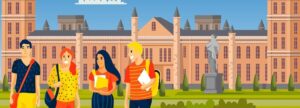Mathematics and art turn out to be rival superstars in the field of human expression as they interact in an intriguing way depicting the primacy of creativity and logic. Mathematical patterns that we can see in almost the entire art of different cultures can be connected with our ancestors knowledge and power they used to reveal their perspective of the world. From the intricate geometry of Islamic architecture to the mesmerizing landscapes of digital art, the link between mathematics and art remains a source of inspiration and exploration for centuries. This blog will shift your perspective to this striking world and show you how, with mathematics, economics and art come together, changing your idea of creativity for the better.
The Golden Ratio:
Primarily, a broad brushstroke in the history of art being the golden ratio notion, often called nature’s aesthetic framework, form the roots of the connection between art and mathematics. This ratio, a mother-of-all proportion as it were, is seen in nature in plenty – seashell spirals, petal arrangements in a flower, etc. For millennia painters, scuptors and any other artist, generously beginning with the Ancient Greeks and the later Renaissance master Leonardo da Vinci, have been going by the rule of Golden Ratio believing it will give their paintings the beautiful look.

Geometry and Symmetry:
It is geometry’s almost exact shapes and symmetrical forms that artists use as bases for their art creative and arts. One can notice an implication of geometry in nearly all art forms, from classical portraiture where symmetrical faces showcase artistic rules, to in modern movements like Cubism which is the one that experiments with geometric abstraction. Apart from that, symmetrical geometry either, rotational, periodic or translational, creates a sense of order and beauty in art whose balanced imagery can able to capture the viewers eye.
Fractals:
In the world of digital art, Fractals show that the combination of mathematical complexity and artistic representation is a delightful way of expression. Self-similitude and infinite details in fractal patterns – whatever the Mandelbrot set is – for artists become always a breathless source of inspiration. It will lead to a progress of creating complex topographies, abstracted objects, and other dimensions that inspire through their fantastic illustrations and defy typical concepts of creation in art forms.
Algorithmic Art:
In present-day times, in with technology, the union of mathematic and art becomes more multidimensional because of algorithmic art. With equations being written into algorithms that then code visual elements, artists are free to work in novel forms of expression and create works of art which may change according to the situation. If we observe algorithmic art through generative art, procedural generation or interactive installation, the line between creator and that which is created, becomes fuzzy, as such, human intelligence and mathematical precision starts to intersect with the audience as they contemplate the issue.
Optical Illusions:
The power which mathematics has over art goes beyond the skills of making an exquisite artwork; it goes as far as the visual concept and illusion of being. Visual deceptions, which are resistant to mathematical reasoning and create spatial, depth and other geometrical relationships, produce an effect wherein viewers are forced to rethink the alternatives and the role of real here and now. Artists explore various mathematical ideas, like how Escher demonstrated tessellations that made viewers re-think the infinity and Riley’s pulsating rhythm that pushed the limits of visual perception, to trigger their imagination and sense of the unknown.
Humanization of the given sentence:
Having entered into the data-flooded era, the graphical illustration is now powerful tool by which very complex information is graphically presented in a visually appealing manner. Usage of the geometric math, color theory and graphic design as tools, data visualization, can be looked upon as a language of emotions that tells a story and educates people, however, the way they do so is very interesting and visually appealing. Via wall paintings, or combining of their talents in artistic work, they make it easy to see the world around, by employing the data generated by computers and stimulate the reflection about the social issues.

Conclusion:
Upon putting together the puzzle of art and mathematics a dynamic composition of imagination and reason emerges out creating the artworks of immense beauty and abounding knowledge. Despite numerous variations and difficulties, from the classic symmetry of the Golden Ratio to the fractals’ interminable complexity, mathematics sill remains a powerful source of inspiration for artists from every field and every tradition worldwide. As we further investigate the synthesis of art and science, we inner anew aesthetic angles and break through



